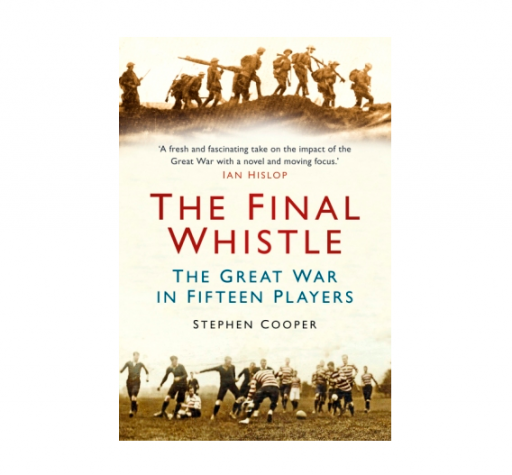Stephen Cooper’s book, The Final Whistle, tells the story of 86 members of Rosslyn Park rugby club who lost their lives during the First World War. He talks to Centenary News’ Dan Hayes.
Rosslyn Park is a rugby club whose home ground is in Roehampton, southwest London. Today it occupies a respectable place in the sport’s third division but, for many years before the advent of professionalism, it was one of the UK’s top-flight teams.
Knowing the long history of the club, one of Rosslyn Park’s members, Stephen Cooper, was surprised to discover it had no memorial to those players who had been killed in the First World War.
He was even more surprised to discover that this important piece of club memorabilia had actually somehow been lost when Rosslyn Park moved grounds in 1956.
‘I decided to try and find out about that memorial and those who were listed on it,’ he says. ‘The club had a record book stored away and that listed 72 people as well as press cuttings about some of them.
‘I began by trying to match those names with the listings of the Commonwealth War Graves Commission, then trying to find a secondary match to be sure I had the right person.
‘The total is now up to 86. One reason for this is that some of the men who were killed played for the club way before the secretary of 1919 would have been around – some as far back as the 1880s.
‘I also discovered a Frenchman who had played for Rosslyn Park in 1910. I found a rather curious name, Jean-Jacques Conilh de Beyssac, in the club’s minute book, googled it and found a French rugby international who had played for Bordeaux and won five caps for France.
‘He was descended from one of Napoleon’s generals and I suspect he was something of a perpetual student who ended up living in Richmond [a suburb of London] for a time. Although he played for France there is no evidence from the Rosslyn Park team sheets that he was ever selected for the club’s first team.’
Even so, in April 1914 de Beyssac played for his country against England at Stade Colombes. Facing him were two other Rosslyn Park players, Arthur Dingle and Arthur Harrison.
Three years later, in April 1917, the French international took part in a game for a national military XV against a combined Australian/New Zealand forces team at the La Cipale velodrome in Vincennes, in a rare wartime rugby ‘international’. This challenge for the ‘Coupe de la Somme’ was won 40-0 by the ANZACs.
De Beyssac died of his wounds in June 1918, aged 28, and is buried at St Remy l’Eau, Oise.
The two former team-mates who played in that 1914 England-France clash also did not survive the war. Dingle was killed at Gallipoli in 1915 while serving with the East Yorkshire Regiment. Harrison died at Zeebrugge in 1918 while taking part in a raid on the port. He was awarded a posthumous VC.
Captain AFB Carpenter of HMS Vindictive, from which the attack was launched, wrote in his 1921 account The Blocking of Zeebrugge: ‘Harrison’s charge down that narrow gangway of death was a worthy finale to the large number of charges which, as a forward of the first rank, he had led down many a rugby football ground. He had “played the game” to the end.’
In 1914 Rosslyn Park had around 350 members, so those 86 fatalities represent an extremely high percentage.
Says Cooper: ‘Rugby was a public school dominated sport and boys from those schools tended to become officers – for whom casualty rates were considerably higher than for other-ranks. They would be the first over the top and they would be peering over parapets where they were at risk of being shot by snipers. A lot of those on the memorial were killed in this way.’
One of these was AF Todd, former Mill Hill School and Cambridge University student, cricketer for Berkshire and rugby player for England and the British Isles.
Todd served in the Boer War in 1899-1900 and was commissioned as a lieutenant in the Norfolk Regiment in 1914 at the age of 41. He was 6ft 2in tall and a giant of a man for the standards of the day. While researching in the National Archive at Kew, Cooper discovered that Todd’s men had expressed concerns about the dangers to which he was exposed on account of his height.
One, referred to in the report as private Coleman, said: ‘He seemed perfectly regardless of his danger and two or three men remarked that if he stayed there he was bound to be hit, and suddenly they saw him fall.’
Todd is buried at Poperinghe military cemetery and, strangely, is also commemorated on the Menin Gate, the memorial to the British missing at Ypres.
Cooper found that the stories of the men and the memorial covered all aspects of the First World War. ‘They told the story of people from privates, to officers, to VC winners and included every theatre of the war. There were two who were childhood friends who died a few thousand yards from each other.
‘There was also a pilot who was killed on 22 August 1914. Lieutenant Charles Bayly was the great nephew of Gordon of Khartoum and was almost certainly the first casualty from the RFC and probably the first ever aircrewman to be shot down in a war.
‘His aircraft was hit by ground fire, but it’s by no means certain exactly how this happened, though it could have been from an artillery battery.
‘Today he’s been largely forgotten. I can guarantee there isn’t any history of the RFC that mentions him.’
Stephen Cooper’s book, The Final Whistle, is published by the History Press.
© Centenary Digital Ltd & Author
